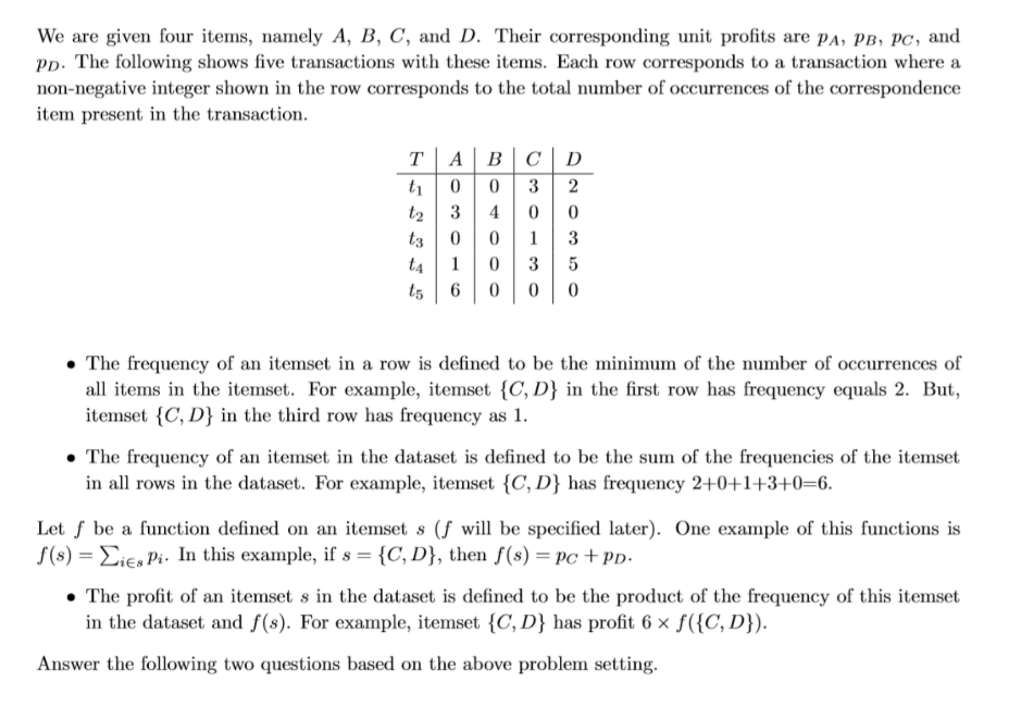

We are given four iteins, nanely A, B, C, and D. Their corresponding unit profits are PA, pB, pc, and PD. The following shows five transactions with these items. Each row corresponds to a transaction where a non-negative integer shown in the row corresponds to the total number of occurrences of the correspondence item present in the transaction. T ABCD t23 400 t3003 t560 00 The frequency of an itemset in a row is defined to be the minimum of the number of occurrences of all items in the itemset. For example, itemset C, D in the first row has frequency equals 2. But, itemset C, D) in the third row has frequency as 1 The frequency of an itemset in the dataset is defined to be the suin of the frequencies of the itemset in all rows in the dataset. For example, itemset {C, D has frequency 2+0+1+3+0-6. Let f be a function defined on an itemset s (f will be specified later). One example of this functions is f(s)-Es Pi. In this example, if 8-(CD), then f(s)-PC + PD . The profit of an itemset s in the dataset is defined to be the product of the frequency of this itemset in the dataset and f(s). For example, itemset {C, D} has profit 6 f((C, D}) Answer the following two questions based on the above problem setting. Question 2. [5 marks] Assume f(s)-Es Pi. Suppose that we know PA-5, pB-10, PC-6, and PD-4. We want to find all itemsets with profit at least 50. Can the Apriori Algorithm be adapted to find these itemsets? If yes, please write down the pseudo-code and illustrate it with the above example. If no, please explain why. In this case, please also design an algorithm for this problem and write down the pseudo-code. We are given four iteins, nanely A, B, C, and D. Their corresponding unit profits are PA, pB, pc, and PD. The following shows five transactions with these items. Each row corresponds to a transaction where a non-negative integer shown in the row corresponds to the total number of occurrences of the correspondence item present in the transaction. T ABCD t23 400 t3003 t560 00 The frequency of an itemset in a row is defined to be the minimum of the number of occurrences of all items in the itemset. For example, itemset C, D in the first row has frequency equals 2. But, itemset C, D) in the third row has frequency as 1 The frequency of an itemset in the dataset is defined to be the suin of the frequencies of the itemset in all rows in the dataset. For example, itemset {C, D has frequency 2+0+1+3+0-6. Let f be a function defined on an itemset s (f will be specified later). One example of this functions is f(s)-Es Pi. In this example, if 8-(CD), then f(s)-PC + PD . The profit of an itemset s in the dataset is defined to be the product of the frequency of this itemset in the dataset and f(s). For example, itemset {C, D} has profit 6 f((C, D}) Answer the following two questions based on the above problem setting. Question 2. [5 marks] Assume f(s)-Es Pi. Suppose that we know PA-5, pB-10, PC-6, and PD-4. We want to find all itemsets with profit at least 50. Can the Apriori Algorithm be adapted to find these itemsets? If yes, please write down the pseudo-code and illustrate it with the above example. If no, please explain why. In this case, please also design an algorithm for this problem and write down the pseudo-code








